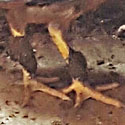
Anyone who has had chickens for more than a few days soon discovers that they will eat or trample all the vegetation growing near their coop, eventually turning lush grass into bare soil. In a rainy climate, or during times of unusually heavy rainfall, the soil can rapidly become a sea of mud in which disease-causing microbes and parasite-carrying insects thrive.
Soil that is either sandy or gravelly may dry rather rapidly. Where the soil is not high in sand or gravel, muddy conditions may be minimized by having a chicken yard that slopes away from the coop. A south-facing slope, open to full sunlight, dries fastest after a rain. Many microbes and parasites — including those that cause the dreaded disease coccidiosis — can’t survive long in the absence of moisture.
Another downside to a muddy chicken yard, besides being unhealthful, is that mud can cling to the chickens’ shanks and feet, drying to create caked-mud anklets and mud balls at the ends of the toes. Mud anklets are unsightly and uncomfortable for a bird, especially one with feathered legs and feet. Mud balls remaining on the toes can grow quite large, eventually leading to crippling or infection.
Many solutions are offered for removing caked mud from a chicken’s legs and feet.
Among the most common are to use a pair of pliers to crack the dried mud, or to gently tap the hard mud with a hammer until it shatters. If not done with great care, either method can result in a broken leg or toe.
To safely remove mud clinging to a chicken’s shanks or feet, stand the bird in warm, not hot, water until the hardened mud has softened, then gently pick it off. Large areas of dried mud may require 15 minutes or more of soaking before the mud softens enough to crumble and come off easily. Sometimes repeated soakings are needed to remove deep layers of caked mud. Finish up by gently brushing the legs and feet with an old soft toothbrush and warm soapy water.
If toes bleed after they’ve been cleaned and dried, coat them with povidone iodine (Betadine). Be sure to take measures to correct the muddy environment that caused the problem in the first place.
And that’s today’s news from the Cackle Coop.
Gail Damerow, author, The Chicken Health Handbook


I am very pleased with my eight week old light brahma pullet, but I’ve never had a chicken with feathered feet and they do get muddy. Is it advisable to wash them?